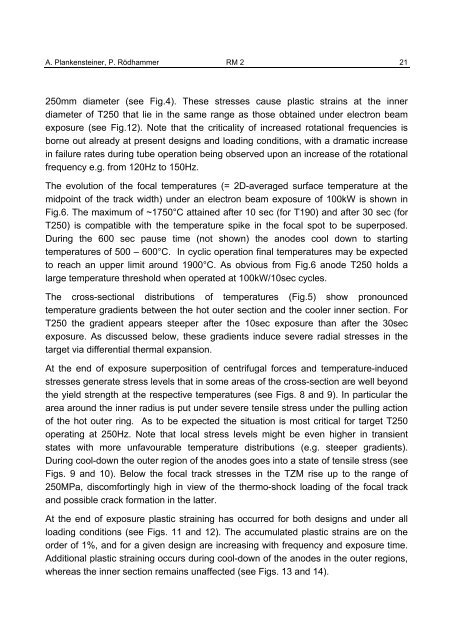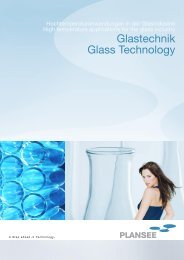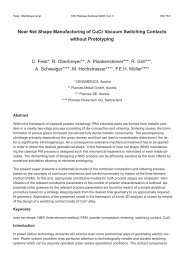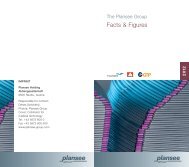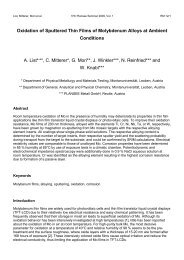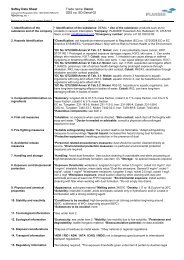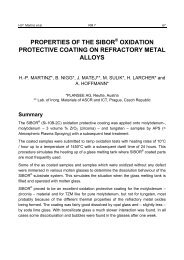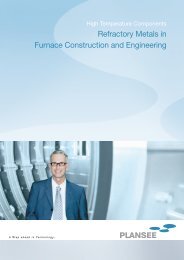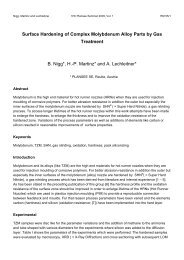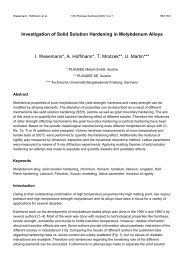Finite Element Analysis of X-Ray Targets
Finite Element Analysis of X-Ray Targets
Finite Element Analysis of X-Ray Targets
Create successful ePaper yourself
Turn your PDF publications into a flip-book with our unique Google optimized e-Paper software.
A. Plankensteiner, P. Rödhammer RM 2 21<br />
250mm diameter (see Fig.4). These stresses cause plastic strains at the inner<br />
diameter <strong>of</strong> T250 that lie in the same range as those obtained under electron beam<br />
exposure (see Fig.12). Note that the criticality <strong>of</strong> increased rotational frequencies is<br />
borne out already at present designs and loading conditions, with a dramatic increase<br />
in failure rates during tube operation being observed upon an increase <strong>of</strong> the rotational<br />
frequency e.g. from 120Hz to 150Hz.<br />
The evolution <strong>of</strong> the focal temperatures (= 2D-averaged surface temperature at the<br />
midpoint <strong>of</strong> the track width) under an electron beam exposure <strong>of</strong> 100kW is shown in<br />
Fig.6. The maximum <strong>of</strong> ~1750°C attained after 10 sec (for T190) and after 30 sec (for<br />
T250) is compatible with the temperature spike in the focal spot to be superposed.<br />
During the 600 sec pause time (not shown) the anodes cool down to starting<br />
temperatures <strong>of</strong> 500 – 600°C. In cyclic operation final temperatures may be expected<br />
to reach an upper limit around 1900°C. As obvious from Fig.6 anode T250 holds a<br />
large temperature threshold when operated at 100kW/10sec cycles.<br />
The cross-sectional distributions <strong>of</strong> temperatures (Fig.5) show pronounced<br />
temperature gradients between the hot outer section and the cooler inner section. For<br />
T250 the gradient appears steeper after the 10sec exposure than after the 30sec<br />
exposure. As discussed below, these gradients induce severe radial stresses in the<br />
target via differential thermal expansion.<br />
At the end <strong>of</strong> exposure superposition <strong>of</strong> centrifugal forces and temperature-induced<br />
stresses generate stress levels that in some areas <strong>of</strong> the cross-section are well beyond<br />
the yield strength at the respective temperatures (see Figs. 8 and 9). In particular the<br />
area around the inner radius is put under severe tensile stress under the pulling action<br />
<strong>of</strong> the hot outer ring. As to be expected the situation is most critical for target T250<br />
operating at 250Hz. Note that local stress levels might be even higher in transient<br />
states with more unfavourable temperature distributions (e.g. steeper gradients).<br />
During cool-down the outer region <strong>of</strong> the anodes goes into a state <strong>of</strong> tensile stress (see<br />
Figs. 9 and 10). Below the focal track stresses in the TZM rise up to the range <strong>of</strong><br />
250MPa, discomfortingly high in view <strong>of</strong> the thermo-shock loading <strong>of</strong> the focal track<br />
and possible crack formation in the latter.<br />
At the end <strong>of</strong> exposure plastic straining has occurred for both designs and under all<br />
loading conditions (see Figs. 11 and 12). The accumulated plastic strains are on the<br />
order <strong>of</strong> 1%, and for a given design are increasing with frequency and exposure time.<br />
Additional plastic straining occurs during cool-down <strong>of</strong> the anodes in the outer regions,<br />
whereas the inner section remains unaffected (see Figs. 13 and 14).


